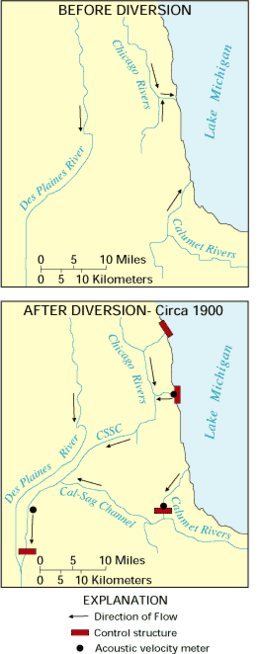41°53′11″N 87°38′15″W / 41.88639°N 87.63750°W
| Chicago River | |
|---|---|
 Chicago River at night in August 2015 | |
 Map of river and flow directions, before and after re-engineering flow via the canal system. Note the "Before" does not show the existing Illinois and Michigan Canal (built 1848), which generally did not affect flow direction. | |
| Location | |
| Country | United States |
| State | Illinois |
| City | Chicago |
| Physical characteristics | |
| Source | Lake Michigan |
| Length | 156 mi (251 km) |
| Basin features | |
| Progression | Chicago River → South Branch → Chicago Sanitary and Ship Canal → Des Plaines River → Illinois River → Mississippi River → Gulf of Mexico |
| Tributaries | |
| • left | South Fork Chicago River |
| • right | North Branch Chicago River |
 | |
The Chicago River is a system of rivers and canals with a combined length of 156 miles (251 km)[1] that runs through the city of Chicago, including its center (the Chicago Loop).[2] Though not especially long, the river is notable because it is one of the reasons for Chicago's geographic importance: the related Chicago Portage is a link between the Great Lakes and the Mississippi River Basin, and ultimately the Gulf of Mexico.
The river is also noteworthy for its natural and human-engineered history. In 1887, the Illinois General Assembly decided to reverse the flow of the Chicago River through civil engineering by taking water from Lake Michigan and discharging it into the Mississippi River watershed, partly in response to concerns created by an extreme weather event in 1885 that threatened the city's water supply.[3][n 1] In 1889, the state created the Chicago Sanitary District (now the Metropolitan Water Reclamation District) to replace the Illinois and Michigan Canal with the Chicago Sanitary and Ship Canal, a much larger waterway, because the former had become inadequate to serve the city's increasing sewage and commercial navigation needs.[4] Completed by 1900,[5] the project reversed the flow of the main stem and South Branch and altered the flow of the North Branch by using a series of canal locks and pumping stations, increasing the flow from Lake Michigan into the river, causing the river to empty into the new canal instead. In 1999, the system was named a "Civil Engineering Monument of the Millennium" by the American Society of Civil Engineers (ASCE).[6]
The river is represented on the Municipal Flag of Chicago by two horizontal blue stripes.[7] Its three branches serve as the inspiration for the Municipal Device,[8][9][10] a three-branched, Y-shaped symbol that is found on many buildings and other structures throughout Chicago.
- ^ "About Friends of the Chicago River". Friends of the Chicago River. Archived from the original on June 14, 2013. Retrieved May 20, 2007.
- ^ "Where is the Chicago River?" Archived October 8, 2014, at the Wayback Machine. Friends of the Chicago River. Retrieved August 18, 2014.
- ^ Hill 2000, pp. 139–151
- ^ Chicago River/Lakeshore Area Assessment (PDF) (Report). Vol. 2. Department of Natural Resources, State of Illinois. October 2000. p. 4. Archived (PDF) from the original on October 9, 2022.[permanent dead link]
- ^ US Army Corps of Engineers (December 26, 2012). How the Chicago District has 'weathered' recent storm events (Report). Archived from the original on February 15, 2013. Retrieved January 12, 2013.
- ^ "Chicago Wastewater System". American Society of Civil Engineers. Archived from the original on January 15, 2012. Retrieved May 15, 2011.
- ^ "Municipal Flag of Chicago". Archived from the original on June 15, 2013. Retrieved May 12, 2010.
- ^ "The Chicago Municipal Device (Y-Shaped Figure)". Chicago Public Library. Archived from the original on September 3, 2006. Retrieved June 20, 2007.
- ^ "The Municipal Device". Forgotten Chicago. Archived from the original on April 9, 2011. Retrieved June 20, 2007.
- ^ "Chicago's municipal device: The city's symbol lurking in plain sight". WBEZ. Archived from the original on September 7, 2014. Retrieved September 7, 2014.
Cite error: There are <ref group=n> tags on this page, but the references will not show without a {{reflist|group=n}} template (see the help page).